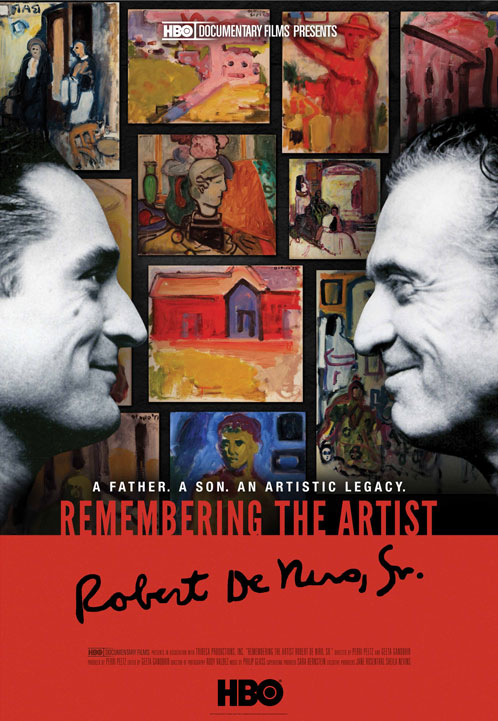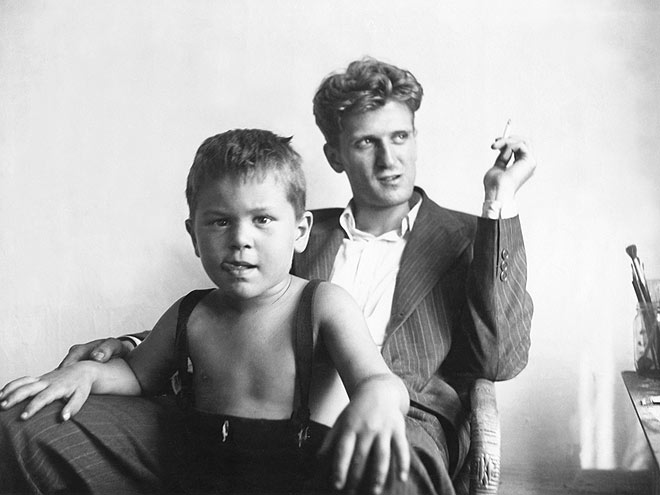HBO’s LGBT History: Remembering the Artist (2014)
 Wednesday, March 2, 2016 at 2:15PM
Wednesday, March 2, 2016 at 2:15PM  Manuel is working his way through all the LGBT-themed HBO productions.
Manuel is working his way through all the LGBT-themed HBO productions.
For the past two weeks, we took an Oscar-themed break by looking back at the 1993 and 2003 acting races. We imagined a world where Ian McKellen and Lily Tomlin could have nabbed another nomination and wondered aloud if Jessica Lange could have earned nomination #7 had HBO films been released theatrically. This week, we're back to our normally scheduled history but there's still an Oscar winner involved: We're looking at Remembering the Artist: Robert De Niro Sr., a documentary on the Taxi Driver actor's artist father.
The detours into hypothetical Oscar history were meant to remind us that HBO’s LGBT content has been consistently strong for over three decades now, at times dwarfing the mainstream fare that has found itself invited to the Oscars this past few years. But sometimes, as we’ll see this week, the HBO imprint is not enough to guarantee that the issue of sexuality will be given its due.
In Remembering the Artist: Robert De Niro, Sr., directors Perri Peltz and Geeta Gandbhir offer us, we’re told early, an attempt by Bobby De Niro to give his father the due that so eluded him in his lifetime (he died of prostate cancer complications in 1993). [More...]
After showing great promise — he exhibited his work at Peggy Guggenheim’s Art of the Century gallery — De Niro found his postwar work out of step with the changing tide of the New York art world. Warhol, Stella, and Kelly would soon be pushing a vanguard that made De Niro’s abstract figurative paintings look old-fashioned in comparison.
It’s an interesting, if, you have to admit, self-serving premise for a documentary, especially one made possible and marketed via the name recognition of the artist’s award-winning son. There’s another story the film hints at, one which complements the Post-War American Art History lesson we’re given. It’s a story about a man living in New York in the middle of the twentieth century struggling with his sexuality. Remembering the Artist is most frustrating in how it sidesteps this more fascinating aspect of De Niro’s story. At first we’re told that ever since he was young he was “different” and “unconventional” though De Niro Jr. struggles to even talk about his father’s sexuality. This is all the more baffling when we’re offered snippets of De Niro Sr.’s journals read aloud by his son:
“If God doesn’t want me to be a homosexual about which I have so much guilt, he will find me a woman whom I will love and who will love me. Or at least create in me an interest in women as sexual partners.”
But rather than explore the implications of such a pronouncement — or even probe his son for insight into the sheer emotional blow that reading such an account must elicit — the doc frames the story time and time again in terms of belated artistic recognition even when later De Niro Jr. reads out another excerpt that stresses the interrelatedness of these two stories:
“Being a painter is an affection like being a homosexual. One had to have the strength to continue working without the thought of recognition even before or after death, just as one had to have the strength to accept life alone without the thought of a romantic attachment.”
How do you land on including these two illuminating journal entries and not even attempt to contextualize De Niro Sr. in terms of the gay scene in New York in the 40s (he and his wife of four years lived in Greenwich village for God’s sake!), the gay art world of the 50s and 60s (he first studied art in Provincetown!), or even the gay milieu in Paris where De Niro eventually moved to? Much was made about De Niro helping his father come out with this film, but the documentary in front of us seems wary of really grappling with the many generative conversations that his life and work evoke.
 Robert De Niro Sr., 'Garbo as Anna Christie,' 1965, Oil on canvas next to the scene depicted from the 1930 film
Robert De Niro Sr., 'Garbo as Anna Christie,' 1965, Oil on canvas next to the scene depicted from the 1930 film
Art historians, gallerists, and art critics talk extensively about De Niro’s struggles with melancholy and depression, about his exuberant brushstrokes (“the energy of his paint”), even his fascination with Greta Garbo in Anna Christie and yet never do they try to think through in any serious way about his life as a closeted man, his artwork as indebted to a gay sensibility, or extending the refrain that he was a “victim of his time” to bear any importance on him as a man wrestling with his own sexual drives in a pre-Stonewall world. Ultimately, it’s such a missed opportunity that one wonders whether there were any conversations behind the scenes about what not to include in the piece that somehow hampered any sustained engagement with this most fascinating of stories.


Fun Awards Fact: The HBO documentary played at Sundance 2014 which technically means it was “nominated” for the Short Film Grand Jury Prize, but let’s highlight instead the fact that director Geeta Gandbhir would later go on to win an Emmy for her work on Spike Lee’s dazzling New Orleans docuseries When the Levees Broke: A Requiem in Four Acts.
Next Week: We go diving with the HBO doc, Back on Board: Greg Louganis, an HBO sports documentary on the Olympic athlete.




Reader Comments (4)
In my mind I'm comparing "Remembering the Artist" with Sarah Polley's "Stories We Tell".
Polley was very frank and very head on about examining her mother's life, which made her documentary totally absorbing. She was unflinching and her Mother and herself.
It sounds like Robert De Niro just couldn't bring himself to be that honest, which is why the documentary suffers.
Considering how withdrawn is usually DeNiro, I find particularly moving that he decided to do this doc.
Love DeNiro in unpredictable roles, it really shows his versatility!
Great post man, will definitely check this movie out!